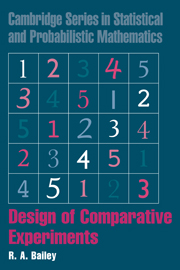Book contents
- Frontmatter
- Contents
- Preface
- 1 Forward look
- 2 Unstructured experiments
- 3 Simple treatment structure
- 4 Blocking
- 5 Factorial treatment structure
- 6 Row–column designs
- 7 Experiments on people and animals
- 8 Small units inside large units
- 9 More about Latin squares
- 10 The calculus of factors
- 11 Incomplete-block designs
- 12 Factorial designs in incomplete blocks
- 13 Fractional factorial designs
- 14 Backward look
- Exercises
- Sources of examples, questions and exercises
- Further reading
- References
- Index
14 - Backward look
Published online by Cambridge University Press: 30 October 2009
- Frontmatter
- Contents
- Preface
- 1 Forward look
- 2 Unstructured experiments
- 3 Simple treatment structure
- 4 Blocking
- 5 Factorial treatment structure
- 6 Row–column designs
- 7 Experiments on people and animals
- 8 Small units inside large units
- 9 More about Latin squares
- 10 The calculus of factors
- 11 Incomplete-block designs
- 12 Factorial designs in incomplete blocks
- 13 Fractional factorial designs
- 14 Backward look
- Exercises
- Sources of examples, questions and exercises
- Further reading
- References
- Index
Summary
Randomization
Although randomization is generally regarded as essential, there is less agreement on how to carry it out and on how to verify whether any proposed randomization procedure achieves its objectives. Here I discuss some possibilities.
Random sampling
Many statistics textbooks give the impression that every collection of observations is a random sample. This is rarely the case for designed experiments. Experimental resources are too valuable for us to choose a random subset and ignore the rest. We use the experimental units which are to hand in the laboratory or the field, or we use all suitable volunteers in a clinical trial. In a small trial it is more important that the experimental units be reasonably similar than that they be random, and in a large trial it may be more important that they be representative. If the experimental units are to be working farms, then stratified random sampling can give a representative sample, but in practice we can still use only those farms whose farmer is willing to participate in the experiment.
Example 14.1 (Small trial on volunteers) In Question 2.1, the psychologist needs to choose as his experimental units eleven of the students listed in Table 2.7. For such a small trial, he should choose people of the same sex and approximately the same age. A random sample of eleven people would almost certainly be more variable, giving him less power to detect any treatment difference.
The chief situation in which random sampling plays a role in experimentation is when observational units are much smaller than experimental units.
- Type
- Chapter
- Information
- Design of Comparative Experiments , pp. 271 - 290Publisher: Cambridge University PressPrint publication year: 2008



